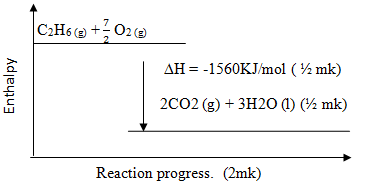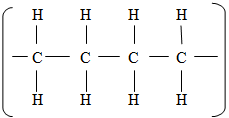-
- Hydrogen (1mk) and carbon (1mk)
-
- It extinguishes because CO2 will accumulate around it putting it off (2mks)
- Mass increases since water vapour reacts with CaO and forms Ca(OH)2 which reacts with CO2 gas to produce CaCO3 and so the mass increase (3mks)
- Nitrogen or helium or neon or argon. (2mks)
- It absorbs moisture which is produced from burning candle. (1mk)
- Sodium hydroxide (1mk)
-
-
- H. its outer electron can be lost easily since its far from the nucleus hence not held strongly. (2mks)
- B (1mk)
- D (1mk)
- A. It has a small radius hence its outer electron is held strongly by the protons (2mks)
-
- CaCl2 and MgCl2 consists of ions which are free to conduct electricity in molten or aqueous state unlike CCl4 and SiCl4 which exists or consists of molecules (2mks)
- Neon diffuses faster since its mono atomic hence lighter unlike Fluorine which is diatomic thus heavy.
-
-
- A neutron is a sub-atomic particle with no charge while a proton is sub-atomic particle with a positive charge. (1mk)
- A radioactive substance is that with unstable nucleus hence undergoes spontaneous disintegration emitting radiations.(1mk)
- Nuclear fussion is the splitting process a heavy nuclide undergoes when bombered by a fast moving neutron. Nuclear fusion is the fusing of light nuclei combine together when they are made to collide at high velocity. (2mks)
-
- Gauging the thickness of thin metal and paper sheets.
- Manufacture of nuclear weapons and atomic bombs.
- Sterilization of surgical instruments using gamma radiation.
- Detecting leakages in underground water or oil pipes without digging them.
-
- I (2+3) – 1 = 4 (1mk) II 91+1) – 0 = 2. (1mk)
- Nuclear fusion (1mk)
- Is the time taken for a radio active substance to decay to a half of its original amount. (1mk)
- 288g _1____144g _2_____ 72g _3________36g _4______ 18g _5______ 9g _6_____
5 half life → 40 days
1 half life → 40 × 1/5 = 8 days. (2mks)
-
-
- Channel or pump sea water into shallow ponds. Evaporation of water occur at the ponds and sodium chloride crystallizes out. (2mks)
-
- NH3(g) + CO2(g) + H2O (l) → NH4HCO3(aq) (1mk
- NH4HCO3(aq) + NaCl(aq) → NaHCO3(s) + NH4Cl (aq) (1mk)
-
- Filtration (1mk)
- Heating (1mk)
-
- Na2CO3 (aq) + H2SO4 (aq) → Na2SO4(aq) + H2O(l) + CO2(g) (1mk)
Moles of H2SO4 = 40 × 0.5/1000 = 0.02 moles = moles of Na2CO3 (1mk)
Mass of Na2CO3 = 0.02 x 106 = 2.12 (1mk) - Percentage purity = 2.12 × 100/2.15 = 98.6% (1mk)
- Used in:
- Textile industries
- Manufacture of glass
- Photography
- Making of acid drugs
- paper industries
- Making of detergent
- Softening hard water.
- Na2CO3 (aq) + H2SO4 (aq) → Na2SO4(aq) + H2O(l) + CO2(g) (1mk)
-
-
- The heat change when mole of substance is formed from its constituent elements in their standard state. (1mk)
-
- Heat of combustion of hydrogen (1mk)
Heat of formation of water. (1mk) -
- 2CO2(g) + 3H2O(l) →C2H6 + 7/2O2 ∆H = -1560KJ/mol ( ½ mk)
2C(s) + 2O2(g) → 2CO2(g) ∆H = -788 (Multiply equation by 2) ( ½ mk)
3H2(g) + 3/2O2(g) → 3H2O (g) ∆H = -858KJ ( ½ mk)
2C(s) + 3H2(g) → C2H6 ∆H = -86KJ/mol ( ½ mk -
- Heat produced = 500 × 4.2 × 21.5/1000 = 45.15KJ (1mk)
- Moles of ethane = 45.15/1560 = 0.02894 moles (1mk)
Mass = 0.2894 x 3.0 = 0.868g (1mk)
- Heat of combustion of hydrogen (1mk)
-
-
- 2, 2 – dimethylpropane or dimethylpropane. (1mk)
- pent – 2 – yne (1mk)
- Add acidified KMnO4 solution to both separately. Pent-2-yne will turn KMnO4 from purple to colourless while dimethylpropane will have no effect. (2mks)
-
- lethylethanoate ( ½ mk) (II) N-ethane ( ½ mks)
-
- Reagent – water condition (1mk) Concentrated sulphuric (VI) acid.
- I Step 2 – esterification (1mk)
II Step 3 – Substitution (1 mk)
-
(2mks)
-
-
- To remove impurities which can poison the catalyst.
- A – Air ( ½ mk) B – Ammonia gas ( ½ mk)
- D – Catalystic chamber (1mk) E – Cooling chamber (1mk) F – Absorption tower. (1mk)
-
- Chamber D
4NH3(g) + 5O2(g) → 4NO(g) + 6H2O(g) (1mk) - Chamber F
4NO2(g) + O2(g) + 2H2O (l) →4HNO3(aq) (1mk)
- Chamber D
- Pressure 9 atm or catalyst (platinum – rhodium) (1mk)
- Fractional distillation (1mk)
-
- Manufacture of nitrogenous fertilizer. (1mk)
- Etching of metals
- There is production of NO gas which is oxidized by air to NO2 gas which is brown. (1mk)
Join our whatsapp group for latest updates
Tap Here to Download for 50/-
Get on WhatsApp for 50/-
Download CHEMISTRY PAPER 2 Marking Scheme - 2017 MURANG'A MOCK EXAMINATION.
Tap Here to Download for 50/-
Get on WhatsApp for 50/-
Why download?
- ✔ To read offline at any time.
- ✔ To Print at your convenience
- ✔ Share Easily with Friends / Students



